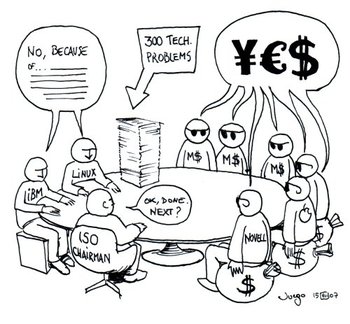98.4% of the OOXML Proposed Dispositions were approved by a three to two majority at the BRM, validating OOXML
The OOXML Proposed Dispositions OOXML were overwhelmingly rejected by the delegations in attendance at the BRM, indicating the inability of OOXML to be adequately addressed within the “Fast Track” process
(Source: ConsortiumInfo.org)
So, depending under what flag you’re sailing and which sources you’re about to trust, you’ll probably hear two different press releases in the next days: One which is telling you that OOXML was approved on the BRM because it got the majority of approval votes (while this source will probably not tell you that this vote was backed by only six delegations) and another source which will tell you that OOXML failed miserably at the Geneva BRM, because the majority of delegations disapproved, abstained or didn’t even voted on protest (a total of 26 delegations).
Now, apparently it became clear pretty quickly that the delegates couldn’t address all raised 1.100 comments in only five days, so the “solution” to this dilemma seemed to have been proposed on Wednesday: Only 20 20 – 30 (!) substantial dispositions were discussed and voted upon, another 200 ones which basically addressed spelling and grammar errors where fixed as well, and on a whopping amount of 900 comments was not worked at all, but voted today. Now that puts the “approval” under quite a different light, doesn’t it?
The above quoted article now draws a few possible conclusions from the “result”:
- As many have contended, the Fast Track process was a totally inappropriate process for Microsoft and Ecma to have adopted for OOXML
- OOXML has not been adequately addressed within that process to be entitled to final adoption
- It would be inappropriate for the ISO/IEC members to approve the adoption of OOXML in the thirty day voting period ahead
Whatever ISO decides after this corrupted standardization process took place and whatever the next actions of ECMA / Microsoft will be – personally I hope they get their fast-tracked, rushed “standard” throwed back at their head with a nice “do your homework again” message – it starts to manifest that every existing OOXML implementation to date is about to get dead meat within the next weeks.
Oh, and a last one, not really on-topic with respect to the BRM ending, but still worth a read if you’re interested in a comparison between SVG and Microsoft’s DrawingML used in OOXML…
[Update: Rob Weir blogs about his experiences during the BRM as part of the US delegation – very interesting read!]
